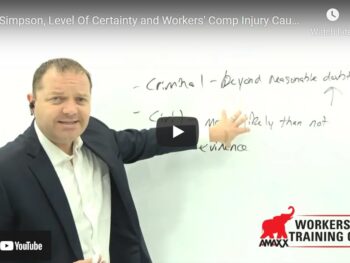A case still being argued in NY’s highest court (Auqui v. Seven Thirty One, Ltd. Partnership.) may very well result in lower negligence costs for high risk employers, such as in construction and transportation, where an injury results in both a comp claim and a negligence suit.
Workers Compensation Provided Money During Negligence Claim
In the past, it was taken for granted that the comp claim provided a fast, albeit small, stream of wage loss money and medical treatment, both essential to “financing” a negligence claim, which would take years to resolve. Furthermore, until a few years ago, the worker would always be found to have a continuing, permanent disability – which could be used to bargain for a larger negligence settlement.
But in recent years, the sheer volume in NY of permanent disability findings in comp were so expensive, and so out of line with other states, that a series of changes were made to halt the rubber-stamp “permanent disabilities”.
New Case Changed Influence of Work Comp on Negligence Settlement
Recently, the inevitable happened. A food truck delivery worker has hit by plywood which blew off a construction site. The worker filed a comp claim and then sued the premises under construction. But, long before serious settlement talks could begin on the negligence case, the Workers’ Compensation Board found that the worker no longer had a continuing disability. That, of course, completely changed the expected outcome.
What followed was a long series of motions in the higher courts on the issue of whether the Board’s findings could be used as determinative in the negligence claim. The last finding by the highest court was that the Board’s determination was indeed binding under “collateral estoppel”.
Currently, there are motions pending to reargue the finding, with nine outside parties (mostly unions and attorney interest groups) filing “amicus curiae” briefs. This means that although they are not part of the claim they have great interests in the outcome and are offered a chance to submit an argument.
Transportation & Construction Could See Lower Workers Comp Costs
So, what does this mean for employers in transportation and construction? It means that the number and duration of their compensation claims can be expected to shrink significantly. The new Board procedures and guidelines, if upheld, will place a large downside on keeping a comp claim open, and running the risk of having the rug pulled out as the time for settlement approaches.
The seriousness of pending decisions can be measured by the presence of amicus briefs, which, overall, are rather rare – especially in comp. So employers should be aware that something is in the works which could very well lower comp costs.
Author: Attorney Theodore Ronca is a practicing lawyer from Aquebogue, NY. He is a frequent writer and speaker, and has represented employers in the areas of workers’ compensation, Social Security disability, employee disability plans and subrogation for over 30 years. Attorney Ronca can be reached at 631-722-2100. medsearch7@optonline.net
Editor Michael B. Stack, CPA, Director of Operations, Amaxx Risk Solutions, Inc. is an expert in employer communication systems and part of the Amaxx team helping companies reduce their workers compensation costs by 20% to 50%. He is a writer, speaker, and website publisher. www.reduceyourworkerscomp.com. Contact: mstack@reduceyourworkerscomp.com.
©2013 Amaxx Risk Solutions, Inc. All rights reserved under International Copyright Law.










